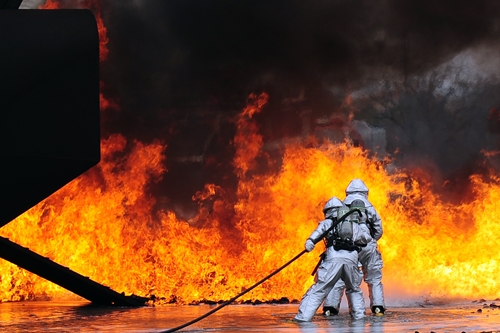2 October 2015. Materials scientists and chemists designed a polymer additive that reduces the explosive nature of jet fuel in crashes or terror attacks, without compromising the fuel’s performance. Researchers from California Institute of Technology and Jet Propulsion Laboratory in Pasadena published their findings in today’s issue of the journal Science (paid subscription required).
The team led by Cal Tech polymer chemist Julie Kornfield is seeking to solve the problem of jet fuel’s highly explosive property, particularly under traumatic conditions such as high-impact crashes or terror attacks like those on 11 September 2001. That explosiveness is a result of the mist of jet fuel and compressed air that ignites and explodes under controlled conditions in jet engines, which powers the airplane’s flight.
That same misting quality, however, can also intensify the fire and explosion when ignited in uncontrolled conditions, such as a crash, where the mist causes jet fuel to rapidly disperse and catch fire more easily. The research team sought a solution that would allow for the usual misting of the air-fuel mix under normal circumstances — retaining other properties of the fuel, such as energy content and density — yet reduce misting under other than normal conditions.
That solution is ultra-long polymer chain known as megasupramolecules. Ultra-long polymer additives were studied beginning in the 1970s as a way of reducing post-impact explosions, with little apparent success. After 11 September 2001, interest was renewed in these materials, and efforts began to design an entirely new type of polymer to meet the demanding requirements of jet engines.
By 2006, researchers in Kornfield’s lab showed it was hypothetically possible to construct individual polymer chains small enough to fit through and not clog the filters and pumps in jet engines, as long as they could dynamically associate with each other into ultra-long polymer chains to reduce misting in a crash. Research scientist Ming-Hsin Wei, a co-first author of the Science paper, began in 2007 to turn that hypothesis into a solution.
In finding that solution, Wei was helped by catalysts developed in the lab of Cal Tech chemist Robert Grubbs that made it possible to add molecules to the ends of polymer chains that easily connect and disconnect like velcro. With further help from engineers at Jet Propulsion Laboratory, Wei discovered a method for connecting the short chains into ultra-long polymers that can prevent the uncontrolled fuel mists causing intense fires and explosions.
In lab tests and simulations, the polymer molecules were found to remain unconnected when under the normal high-pressure conditions of a jet engine. When the pressure is relaxed and fluid elongates, the short polymer chains connect with the velcro-like molecules at their ends, resulting in the ultra-long megasupramolecules, which suppress the misting and the fuel’s explosive nature.
The following brief (45 second) video, narrated by Kornfield, shows the difference in explosiveness between fuel samples with and without the polymer additive. The researchers say their tests and simulations show engines powered by fuel with the additive display the same power and efficiency as engines burning fuel without it.
Wei says in a university statement that he plans to design a reactor to produce the additive within one year. Cal Tech applied for a patent on the discovery.
Read more:
- Navy Seeks Graphene Nanoribbons for Electricity Distribution
- Synthetic Spider Silk Developed with Customized Properties
- New Adaptive Aircraft Control System Flight Tested
- Synthetic Polymer Shown to Reduce Heavy Bleeding
- Material Developed to Prevent Li-Ion Battery Fires
* * *


 RSS - Posts
RSS - Posts
You must be logged in to post a comment.